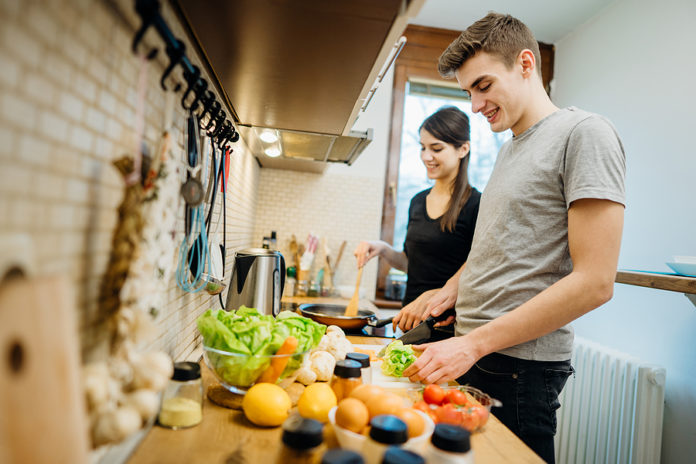
Before the pandemic, I ate out a couple of times a week. For the past year, except for occasionally ordering out, I’ve mostly cooked at home. I’m excited to visit my favorite restaurants again when the crisis is over, but I also plan to continue mostly cooking at home.
According to the latest data from Deloitte’s Global State of the Consumer Tracker, I’m pretty normal — 42% of U.S. consumers expect to cook at home more post-pandemic than they did pre-pandemic. Only 7% say they will cook less. In addition, 12% say they will eat at restaurants less, while 20% will order takeout or delivery more.
These findings suggest that the post-pandemic normal may not look much like the pre-pandemic normal. Many food and beverage companies — from CPG companies to retailers and foodservice — have had to adjust their operations during COVID-19, and many of those changes may stick around, at least for the medium term.
To learn more about the implications of COVID-19 for the future of the food and CPG industries, I spoke with Barb Renner, Deloitte’s vice chairman and U.S. leader of consumer products.
More post-pandemic trends
Fresh food will continue to be in high demand
The trend toward fresh food had been growing already, and the pandemic accelerated its growth. In Deloitte’s 2020 fresh food consumer survey, nine out of 10 people said fresh food makes them happy. The current study found that 29% of consumers plan to buy fresh food more after the pandemic than they did before.
“Fresh had obviously been increasing over the last five-plus years, but with the pandemic it took a significant jump,” Renner said. “And we know that 80% of the consumers that go into a grocery story go in because of fresh.” This trend is driven both by the desire for a healthy lifestyle as well as the fact that during the pandemic people simply have more time to prepare fresh foods.
To accommodate this demand, as well as the sudden shut down of restaurants and foodservice, many CPG companies transformed their operations. “Let’s say that you’re a protein company and you sold meat in 40-pound boxes. You can’t sell 40-pound boxes to an individual at retail,” Renner noted. To compensate, companies had to change their lines, their packaging, and their logistics to get their product to consumers.
As it turns out, these changes that helped them weather the storm at the height of the pandemic may be advantageous in the long term if consumers continue to buy fresh food to eat at home.
Restaurant dining will be lower than pre-pandemic, in part because of working from home
In Deloitte’s survey, 12% of people said they plan to eat at restaurants less post-pandemic than they did pre-pandemic. But there are some nuances to this finding.
It’s not that people won’t eat at restaurants at all, Renner noted, it’s a change in when they eat at restaurants. Namely, the switch to working from home means fewer meals out. “We expect to see at least double the number of people working remotely post-pandemic as we saw pre-pandemic. And with those people working from home, it’s less likely that they’ll have breakfast out.”
The same is true for lunch. “You won’t see them going out to lunch at restaurants or quick-serve restaurants as much because they’ll be working from home.”
Deloitte identifies two other factors that will contribute to the increase in eating at home:
- Economic — Many Americans have suffered financially during the pandemic, and cooking is cheaper.
- Preference — People have gotten better at cooking, and many have found that they enjoy it. Not only that, but “with the psychological scars of the pandemic, some consumers will prefer to continue avoiding crowded spaces,” the company writes. “When they want restaurant food, they might order it for delivery.”
Safety as a driver of purchasing behavior
The three traditional drivers of food purchasing behavior have always been price, taste, and convenience. But in the past few years, consumers have started to look beyond these drivers to factors like sustainability and social impact. Delotte found that during the pandemic, “a new factor, safety…has essentially tied with price for first place.”
The idea of safety is multi-faceted. “Not only safety for the consumer, but safety for the employees of the CPG companies as well as retail [companies] and the community at large,” Renner said. “So, you saw companies — retail, CPG, and their suppliers — work to make certain that they were supporting their employee base with PPE [personal protective equipment] so that they could keep the environment safe for them. That has an impact on overall profitability.”
Renner notes that companies are continuing to look at actions they need to take to make certain they’re keeping their employees safe, both from the employees’ perspective and also from the consumers’ perspective.

5 ways CPG companies are preparing for the future
To help CPG companies adjust to and capitalize on the shifting consumer trends, Deloitte interviewed CPG executives to identify what they call “five ‘no-regret’ strategic moves.”
1. Resetting go-to-market strategies
E-commerce, direct-to-consumer, omnichannel — the pandemic forced companies to adopt new go-to-market strategies in a hurry. Renner noted a significant amount of innovation in this space, which also includes subscription models and partnerships. For example, some quick-serve restaurants have added pantry items to their menus, while others are expanding their drive-through services with the possibility of eliminating in-restaurant dining altogether.
2. Accelerating the shift to digital
DTC strategies like e-commerce represent only part of the “digital acceleration” that’s happening in the industry. CPG companies are also investing in work-from-home platforms, enterprise technology, cybersecurity, and new technologies like robotic process automation and artificial intelligence. “We’re monitoring all the commitments on digital that CPG companies were making to the…analysts,” Renner said. “And we’ve seen that most are doubling down on their digital strategy.”
3. Building supply chain resilience
CPG companies are acting quickly to fix the supply chain weaknesses that the pandemic exposed, and nine in 10 say they’re making significant progress.
One of the biggest problems Renner identified was an over-reliance on a small number of vendors. “If they were getting their product from a handful of vendors and one of those vendors had to close down, did they try to find an alternative source? I think there were some partnerships that have been inked over this,” so CPG companies can have better backup plans.
4. Investing in tomorrow’s business foundations
To make sure their businesses are set up for the future, many companies have pursued a variety of initiatives including cost-cutting and M&A. Renner notes that cost management was crucial because the pandemic came with increased costs in certain areas, for example, providing PPE and, in some cases, giving workers raises and bonuses.
She also observed that there has been a lot of rationalization — with some companies purchasing brands to expand their lines and others deciding that certain brands no longer fit their portfolio.
5. Connecting purpose to profit
Finally, as mentioned above, consumers are looking beyond price, taste, and convenience when deciding what products to purchase. Three-quarters of the CPG executives Deloitte interviewed said that a “strategy to place purpose alongside profit, express corporate values, and address heightened consumer attention to sustainability, social justice, equality, and environmental consciousness” ranks high on their list for 2021.
In the past, “sustainability is always an important topic, but it wasn’t really funded the way that important topics should be funded,” Renner said. She noted that companies would make commitments, but if they weren’t on track to meet them, they could push them into the future without penalty. “Now, you’re seeing this really significant opportunity to have purpose, but also to have profits with that purpose and unlock value in your product and in your processes so you can actually achieve that environmental, social, and governance goal.”
This, she said, is one of the most impactful outcomes of the pandemic — how companies have responded in a positive way to a significant shift in consumer expectations.
Read more about all of these topics at Deloitte:







